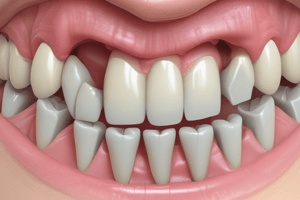Podcast
Questions and Answers
What statistical tests were used for intergroup and intragroup comparisons in this study?
What statistical tests were used for intergroup and intragroup comparisons in this study?
- T-test and Mann-Whitney U test
- Chi-square test and Wilcoxon signed-rank test
- Kruskal-Wallis and Friedman tests (correct)
- ANOVA and Tukey HSD test
What percentage of restorations had to be reintervened after 2 years?
What percentage of restorations had to be reintervened after 2 years?
- 100%
- 96.3%
- 84.35%
- 15.65% (correct)
Which composite showed a statistically significant decreased marginal integrity compared to resin composite at the 2-year evaluation?
Which composite showed a statistically significant decreased marginal integrity compared to resin composite at the 2-year evaluation?
- Resin composite
- Cention N (correct)
- Surefil-one
- Powerfil
What is one of the primary reasons for the failure of resin composite restorations as mentioned in the text?
What is one of the primary reasons for the failure of resin composite restorations as mentioned in the text?
What is one key factor mentioned that can improve the clinical performance of resin composite restorations?
What is one key factor mentioned that can improve the clinical performance of resin composite restorations?
Flashcards are hidden until you start studying
Study Notes
Study on Clinical Performance of Ion-Releasing Bulk-Fill Composites
- A randomized clinical trial evaluated the 2-year clinical performance of two ion-releasing bulk-fill composites (Cention N and Surefil One) compared to a conventional bulk-fill resin composite (Powerfil) in Class I and II cavities.
Materials and Methods
- 32 patients with 3 Class I and/or Class II cavities under occlusion were enrolled in the trial, with a total of 96 restorations placed (32 for each material).
- The restorations were placed by a single operator and evaluated at baseline (1-week), 6-months, 1-year, and 2-years by two independent examiners using the FDI criteria.
Results
- 27 patients with a total of 81 restorations were evaluated at the end of the 2-years with 84.35% recall rates.
- Clinical success rates were 100%, 100%, and 96.3% for Powerfil, Surefil-one, and Cention N, respectively.
- Cention N showed a statistically significant (p < 0.05) decreased marginal integrity in comparison with resin composite at the 2-year evaluation.
- No recurrent decay was detected in any restoration.
Conclusion
- Both ion-releasing bulk-fill composites provided acceptable clinical performance similar to bulk-fill composite in Class I and II restorations over a 2-year period.
Studying That Suits You
Use AI to generate personalized quizzes and flashcards to suit your learning preferences.



